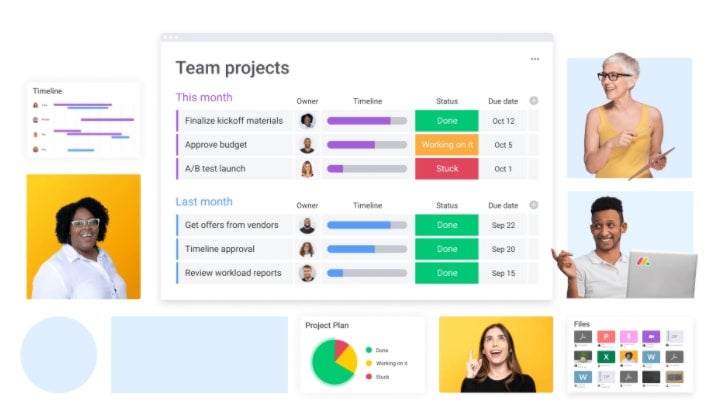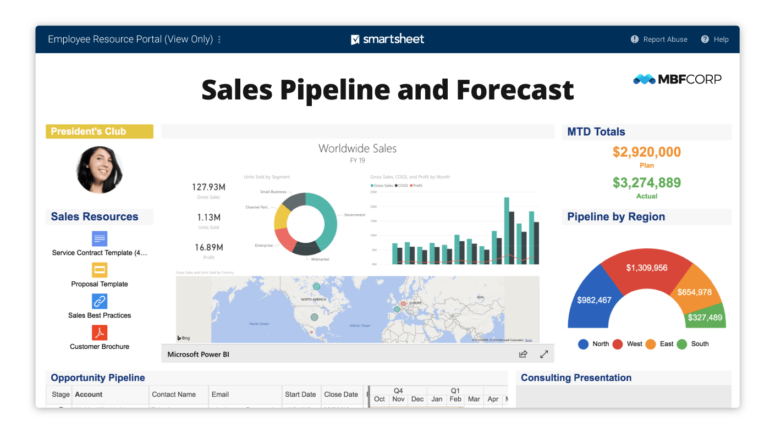A highlight of some of the best collaboration tools for web developers. Learn more about web development collaboration software.
Collaboration tools can help web development teams stay on the same page to improve efficiency and productivity. This guide will discuss the following top collaboration tools for web developers in terms of features, pros, cons and pricing:
- Monday.com: Ideal for web developers looking for a customizable collaboration tool with project management features.
- Trello: Best for web developers looking for collaboration software with a functional free plan that’s easy to use.
- Wrike: Great choice as a collaborative web development tool with file sharing, live document editing and hundreds of integrations.
- Smartsheet: Solid pick for collaborative versatility in a project management platform that relies heavily on spreadsheets.
Jump to:
- Monday.com
- Trello
- Wrike
- Smartsheet
- What to look for in collaboration tools
- Final thoughts on the best collaboration tools for web developers
Monday.com
Monday.com is a popular project management tool for web developers with collaborative capabilities thanks to several in-house features and integrations with some of the top collaboration tools.
Features of Monday.com

Some of Monday.com’s features that make it a popular collaborative web development tool include:
- Document sharing
- Coediting
- Collaboration tool integrations
- Multiple views
- Customizable dashboards and projects
Web developers can easily share files in Monday.com and coedit documents in real time with the Workdocs feature. If you use popular collaborative tools such as Slack, Microsoft Teams, Dropbox, etc., you can keep using them with Monday.com, thanks to seamless third-party integrations.
Other Monday.com features worth mentioning as a project management tool include multiple views — calendar, timeline, Gantt, Kanban, etc. — customizable projects and dashboards and out-of-the-box time tracking.
Pros of Monday.com
Monday.com’s pros include:
- Third-party integrations
- Highly customizable
- Various views
- Customer support
Monday.com’s integrations with popular third-party programmer tools for collaboration are a significant plus, as is its customization. The plethora of views offers flexibility when visualizing progress, and should you need it, Monday.com offers solid customer support and tutorials for help.
Cons of Monday.com
Monday.com’s cons include:
- Pricing
- Task dependencies
- Speed
Some of Monday.com’s most sought-after project management features, such as time tracking, are only available through its pricier plans. Task dependencies could be better, and the developer tool is sometimes sluggish and slow.
Pricing of Monday.com
Monday.com has five pricing plans:
- Free: For up to two users.
- Basic: $8 per user, per month.
- Standard: $10 per user, per month.
- Pro: $19 per user, per month.
- Enterprise: Custom priced.
The Free plan includes three boards, unlimited docs, and more than 200 templates. Basic offers unlimited free viewers and items and priority support. Standard unlocks timeline, Gantt and calendar views, guest access, and 250 monthly integrations and automations. Pro gives you 25,000 monthly integrations and automations, plus time tracking and a chart view. And Enterprise offers ultimate security and governance, premium support, advanced reporting/analytics and custom onboarding.
Trello
Trello is a widely used project management tool made famous for its drag-and-drop Kanban boards, user-friendliness and solid Free plan.
Features of Trello

Some of Trello’s collaborative highlights worth mentioning include:
- Kanban boards
- Comments
- @mentions
- Notifications
- File sharing
- Third-party integrations (Power-Ups)
Drag-and-drop Kanban boards are what Trello is based on, and they’re the project management tool’s most popular feature. Web developers can share their boards with team members and other stakeholders, even without a Trello account.
Team members can comment on Trello cards to share ideas, feedback and collaborate, plus directly call on others via @mentions. Users get notifications when new comments are made or cards are updated so they stay in the loop.
Trello also allows for file sharing and integrates with popular third-party collaboration tools such as Slack and Gmail via its Power-Ups feature.
Pros of Trello
Trello’s advantages include:
- Easy to use
- Intuitive interface
- Free version
- Power-Ups
Even those new to collaboration software can get the hang of Trello in no time, as its interface is easy to understand, and the drag-and-drop functionality works seamlessly. The Free version is great for those getting started or small web development teams with minimal budgets, and Power-Ups offer solid extensibility.
Cons of Trello
Trello’s disadvantages include:
- Limited views
- Basic
- Made for simple projects
Those looking for more views than the Kanban-style boards will have to pay for Trello’s Premium plan. The developer tool is rather basic overall compared to more advanced project management offerings that offer collaboration. As such, Trello is more suited to simpler projects versus large, complex ones.
Pricing of Trello
Trello’s pricing plans follow:
- Free: No cost for individuals and small software development teams seeking basic features.
- Standard: $5 per user, per month.
- Premium: $10 per user, per month.
- Enterprise: $17.50 per user, per month.
The Free plan offers unlimited cards, Power-Ups, storage, two-factor authentication and 10 boards per workspace. Standard offers scalable collaboration for small teams and unlocks unlimited boards, single board guests, custom fields, saved searches and advanced checklists.
Premium adds several views — calendar, table, dashboard, map, timeline, etc. — admin and security features, observers and data export. And Enterprise offers unlimited workspaces, attachment permissions, organization-wide permissions and more.
Wrike
Wrike is one of the biggest names in the project management game due to its multiple views, time tracking, etc. It serves as comprehensive collaboration software with features such as file sharing, proofing, approvals and more.
Features of Wrike

Some of Wrike’s highlights that make it a worthy web development tool for collaboration include:
- File sharing
- Live document editor
- Proofing
- Internal and guest approvals
- Cross-tagging
- Integrations
Web developers can share files by attaching them to relevant tasks, projects and folders, and team members can edit those files via a live document editor. Updates are uploaded automatically in real time to keep everyone on the same page.
Wrike has proofing and makes it easy to compare file originals with their latest versions, internal and guest approvals to accelerate sign-offs and cross-tagging for total visibility without unnecessary work duplication. For even more collaboration, Wrike integrates with over 400 popular programmer tools, including Slack and Zoom.
Pros of Wrike
Wrike’s strengths include:
- Versatile collaboration
- Hundreds of integrations
- Project management perks
- Various views
Wrike gives web developers various ways to collaborate, either through in-house features or third-party integrations with Zoom, Slack and others. Beyond collaboration, it offers plenty of project management perks such as time tracking, automation, real-time reporting and more. And its various views make Wrike attractive to project managers of web development teams looking for multiple ways to visualize progress.
Cons of Wrike
Wrike’s weaknesses include:
- Price
- Complexity
- On-the-go functionality
To unlock some of Wrike’s collaborative features, such as cross-tagging, you must pay for one of its pricier plans. The project management and collaboration software may take some time to learn for beginners, and its mobile app isn’t the best we have seen for on-the-go work.
Pricing of Wrike
Wrike’s pricing tiers are as follows:
- Free: No cost for basic features.
- Team: $9.80 per user, per month.
- Business: $24.80 per user, per month.
- Enterprise: Call for pricing.
- Pinnacle: Call for pricing.
Wrike’s Free plan offers essential task and project management with board and table views. The Team plan unlocks 20 collaborators, unlimited projects, custom fields, tasks/subtasks, request forms, Gantt charts, dashboards and external requester collaboration. Business offers cross-tagging, approvals/guest approvals, and time tracking. Enterprise offers 2FA, user audit reports, custom access roles and other security features. And Pinnacle offers advanced reporting, job roles, budgeting and more.
Smartsheet
Smartsheet is project management and collaboration software that can help web development teams stay on the same page via conversations, feedback forms, etc., and save time with drag-and-drop automations.
Features of Smartsheet

Some of Smartsheet’s top features for collaboration include:
- File attachments
- Content collaboration
- Conversations
- Forms
Web developers can use Smartsheet to attach several different types of files and keep them in one easily accessible place for others to view. Team members and clients can view shared content whether they have an account or not and add feedback, emojis, etc., to collaborate and track progress in real time.
Smartsheet has built-in conversations to eliminate the need for separate email threads or chat, and it has forms to collect data from internal and external stakeholders. The developer tool also integrates with Skype, Dropbox, Slack and other collaborative software.
Pros of Smartsheet
Smartsheet’s pros include:
- Team collaboration
- Multiple views
- Time-saving automations
- Reports
Web developers get multiple ways to collaborate in Smartsheet plus multiple views for tracking progress. Its time-saving automations are easy to implement with drag-and-drop, and project managers get the added perk of real-time insights through Smartsheet’s reporting capabilities.
Cons of Smartsheet
Smartsheet’s cons include:
- Reliance on spreadsheets
- Price
- No Kanban boards
While some web development teams may prefer Smartsheet for its spreadsheet-style format, others may prefer more flexibility and the modernized look offered by competitors. The collaboration software’s higher-level plans can get costly for larger teams, and the lack of Kanban boards may be a turnoff for some.
Pricing of Smartsheet
Smartsheet has four pricing tiers:
- Free: No cost for one user and two editors.
- Pro: $7 per user, per month.
- Business: $25 per user, per month.
- Enterprise: Contact for pricing.
Smartsheet’s Free plan offers dashboards, reports, 100 monthly automations, calendar, Gantt, grid, card views and community support. The Pro plan offers unlimited free viewers, sheets, dashboards, reports, forms, user management and integrations. Business offers unlimited free editors and automations, plus proofing and a document builder. And Enterprise adds security, scalability, single sign-on, DocuSign integration, and more.
What to look for in collaboration tools
With no shortage of collaboration software on the market, choosing the right one for your web development needs may seem like a huge chore. Consider several factors when shopping around, and you can filter your results to make that decision easier.
If your web development team is on a tight budget, look at the price of collaboration software first. Many developer tools have free trials or plans, which could sway you in their direction. If some users have limited technical skills, consider user-friendliness. You can find reviews on collaboration software that will tell if it’s intuitive and beginner-friendly.
Beyond price and user-friendliness, look for specific features that fit your web development team’s collaborative needs. Some standard features that facilitate collaboration and can boost overall team productivity include group chat, audio and video conferencing, direct messages, email, @mentions, screen sharing, document editing, file sharing and notifications. And if you already use specific developer tools to communicate, check that they seamlessly integrate with the collaboration software for extended functionality.
Final thoughts on the best collaboration tools for web developers
Team collaboration is a critical component of success for web developers. All of the developer tools listed above promote team collaboration. To make the best decision for your team, compare their features, pros, cons and pricing to ensure you pick the right one for your needs.
